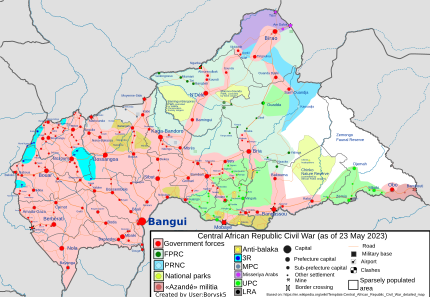Central African Republic Civil War facts for kids
Quick facts for kids Central African Republic Civil War |
|||||||||
|---|---|---|---|---|---|---|---|---|---|
 Current military situation in Central African Republic (For a detailed map of the current military situation, see here) |
|||||||||
|
|||||||||
| Strength | |||||||||
|
ECCAS: 3,500+ peacekeepers |
20,000+ (self-claim, 2022) 3,000 (Séléka claim, 2015) 1,000–2,000 (other estimates, 2014) |
||||||||
| Casualties and losses | |||||||||
| 500+ rebel casualties (Bangui only, South African claim) | |||||||||
|
Civilian casualties:
Unknown number killed or wounded 200,000 internally displaced; 20,000 refugees (1 Aug 2013) 700,000 internally displaced; +288,000 refugees (Feb 2014) Total: Thousands killed 13,594+ killed (Oct 2022) |
|||||||||
The Central African Republic Civil War is an ongoing civil war in the Central African Republic (CAR) involving the government, rebels from the Séléka coalition, and Anti-balaka militias. Many of the insurgents are former combatants from the 2004 civil war who accuse President François Bozizé of breaching peace treaties signed in 2007.
Rebel forces have captured many of the largest towns in the central and eastern regions of the country.
Background
The 2004 civil war began with the rebellion of the Union of Democratic Forces for Regroupment (UFDR) against President François Bozizé, which quickly degenerated into a war. However, in 2007, a peace agreement was reached between the Government and the UFDR that included an amnesty for its members, its legalization as a political party and the integration of its combatants into the Army.
On March 22, 2013, the rebels broke the ceasefire, taking control of the cities of Damara and Bossangoa. Fears arose that Bangui would be taken over at any moment, provoking a panic crisis among the population. On the 23rd, the rebels managed to enter the capital after intense fighting in the neighborhoods surrounding the Government Palace. The following day, the revolutionaries managed to take control of the governmental precinct after intense firefights between them and the defenders of the place. Bozizé fled to the Democratic Republic of Congo and Michel Djotodia was left as interim president of the country. The African Union decided to suspend the country due to the institutional breakdown.
Displaced people
In May 2014, it was reported that around 600,000 people in CAR were internally displaced with 160,000 of these in the capital Bangui. By May 2014, 100,000 people had fled to neighbouring Cameroon, the Democratic Republic of Congo and Chad. As of 2017, there are more than 1.1 million displaced people in a country of about 5 million people, the highest ever recorded in the country, with about half a million refugees outside CAR and about 600,000 internally displaced. Cameroon hosted the most refugees, more than 135,000, about 90% of whom are Fulani, even though they constituted 6% of CAR's population.
In February 2016, after a peaceful election, the former prime minister Faustin-Archange Touadéra was elected president. In October 2016, France announced that it was ending its peacekeeping mission in the country, Operation Sangaris, and largely withdrew its troops, saying that the operation was a success.
In December 2020, after a contested election, rebels known as the Coalition of Patriots for Change or the CPC, have seized main roadways and prevented the flow of goods into Bouar. These and other similar efforts have caused an estimated 100,000 to leave their homes. A month later, January 2021, the number had doubled to 200,000, including 92,000 refugees in the Democratic Republic of the Congo and 13,000 in Chad, the Republic of the Congo, and Cameroon.
International effort
The UN Security Council established a peacekeeping force in April 2014 that incorporated African Union and French forces that had been deployed to Central African Republic previously. The Central African Armed Forces and UN peacekeepers have been largely successful in recapturing towns from rebel groups, but the risk of future rebel activity remains high.
In 2022, United Nations High Commissioner for Refugees (UNHCR) continued its protection-centred work to meet the increasing needs of displaced Central Africans still awaiting durable solutions.
See also
 In Spanish: Segunda guerra civil centroafricana para niños
In Spanish: Segunda guerra civil centroafricana para niños
- List of conflicts in Africa
- Cahier Africain, a documentary which provides one viewpoint on the conflict

